Resident Evil (1996 / 2002)
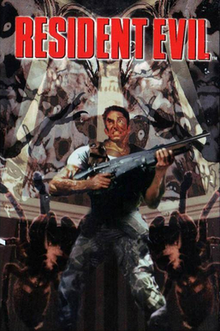

A franchise that I've gotten requests to make monster reviews of is the survival horror game with increasingly over-the-top bio-engineered zombie monsters, Resident Evil. The thing is... I've never actually played a Resident Evil game to completion. I played a bit of RE5, I played a little bit of Revelations (whichever one that's on an underwater base), and I saw parts of a playthrough of the remakes of the first two games and know enough from geek pop culture osmosis and the live-action movies to know some of the more iconic Tyrants and Nemesis and Licker and La Plaga designs... but for the most part, I've never actually finished a single Resident Evil game yet, despite the game arguably defining the 'survival horror' genre and being one of the first games to really bank on atmosphere, story and world-building to carry the game instead of just non-stop actions and puzzles.
That's not going to stop me, though, because like Pikmin (expect a part two to that monster review, too, soon), I'm going to review every single creature in the first Resident Evil game. I guess one of the things about the Resident Evil games is that... there's a lot of them and I'm really not sure how to realyl talk about them. I guess I'll go through the numbered games first? We'll see. Thank you, again, to the fan-wiki for providing the lists of monsters and the pictures to them. With the first 3 Resident Evil games, I've either watched someone play the games or played through parts of it myself, so it's going to be a bit more coherent than the Pikmin.
We'll be covering Resident Evil (a.k.a. Biohazard, for its original Japanese name) which is the very first game in the series released in 1996, and remastered/remade in 2002 for the Gamecube. As with any long-running game franchise, Resident Evil's storyline will get just a mite bit convoluted as we go on through the later games, but the first couple of games have an easy enough story that I can summarize here.
________________________
The Story:
Near the American town of Raccoon City, the police department's elite S.T.A.R.S. unit goes off to investigate a bizarre series of murders and the disappearance of Bravo Team. You, the player, plays as either Chris Redfield and Jill Valentine, as part of the Alpha Team (alongside nice guy Barry Burton and spoiler-alert-he's-a-baddie Albert Wesker) sent to investigate the murders and your missing comrades. Alpha Team gets attacked by monstrous, seemingly-rotting dogs and gets abandoned by their helicopter pilot, and depending on the character you play as, the group gets split up. I'm not going to go too much into the details of the "Chris Path" or "Jill Path" since you'll be encountering different NPC's and uncover different aspects about the story of the mysterious mansion, but you'll basically piece together the full picture of what actually went on if you played through both storylines.
Whichever you choose, though, Chris or Jill will meet monsters (zombies!) and learn that the mansion is a cover for a series of illegal experiments undertaken by a biochemical super-company called Umbrella Corporation, and the zombies and other assorted creatures in the mansion are created by a highly contagious and mutagenic biological agent called the T-Virus. As our heroes travel into the secret underground laboratory, their team member Albert Wesker reveals that he's a double-agent working for Umbrella, and unleashes the complete weaponized creature the Tyrant to kill the S.T.A.R.S. agents. In the chaos, Wesker is seemingly killed by the Tyrant while the player character defeats the Tyrant and activates the lab's self-destruct system -- and depending on choices you make in the game, the number of characters that survive, whether the Tyrant itself is killed or let loose, and whether the mansion blows up will change (although the 'canon' ending, as far as the sequels are concerned, is the best one).
A pretty simple story, and the 2002 remake (sometimes called REmake by the fans) adds a whole extra sub-plot interwoven into the backstory of the Spencer Mansion to help bring a more cohesive storyline and highlight the cruelty of the experiments being done. Overall, it's honestly a pretty fun little integration of classic day-of-the-dead zombie hordes and the idea of a sci-fi, mutagenic virus that transforms not just humans but animals into monsters, too. The original Resident Evil is basically just contained to a single mansion, and due to the limitations of the graphics at that time Resident Evil doesn't have the most expansive bestiary ever... but we'll go through it nonetheless!
____________________________________________________
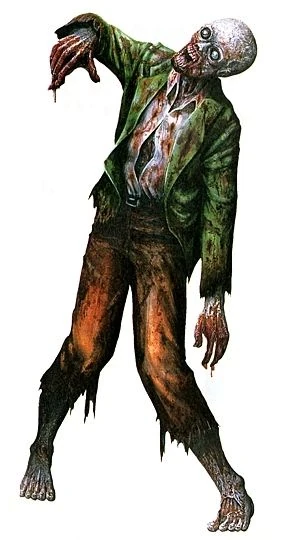
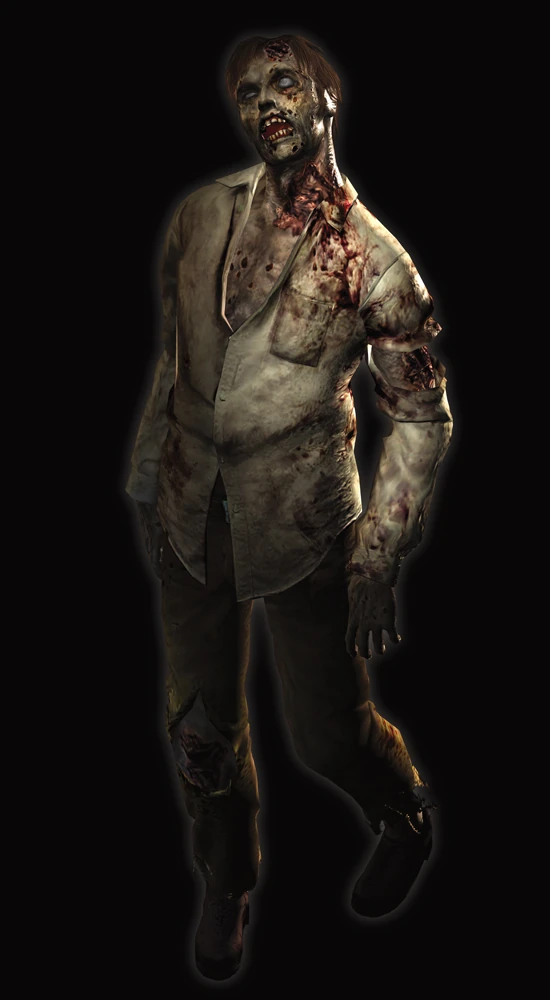
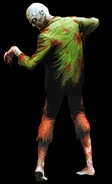
Zombie
Obviously, the basic premise of the game is... survival against zombies. Okay! Or, as the game's blanket term for almost all the monsters -- B.O.W., short-hand for Bio-Organic Weapons. There's honestly really not a whole ton to say here, the Zombie will become a staple of nearly every single Resident Evil game (the ones that don't have a clear equivalent) and they're the backbone of the franchise as a whole. In Resident Evil lore, zombies are humans that have succumbed to the T-Virus, whether exposed through it via a contaminated water supply or being infected (via bites or scratches) from a T-Virus zombie itself. So yeah, not only are these guys the embodiment of humanity's general fear of the death, they'll also spread their death-ness and turn you into one of them. I'm not entirely sure if Resident Evil was the genre definer for zombie-bites that will immediately infect any human unfortunate enough to get chomped on by them... but they're still freaking undead corpses. We all know what zombies are all about, but I'm going to also note that as a franchise that builds itself around zombie-hunting, the Resident Evil games actually do a pretty good job at either utilizing them sparingly or in hordes depending on the game you're playing. As with anything that gets used over and over again they do get admittedly a bit played out in later games, but they're still pretty effectively gross and terrifying.
The game's more sci-fi virus leanings sort of alternate on whether the T-Virus zombies kills the host and turns them into reanimated corpses, or if they infect a human and basically sort of take control of them while causing external changes like the rotting flesh and the cannibalistic urges, making them alive but non-sentient. Either way, though, there's really no saving these wretched bastards. Thanks to the virus turning living humans into bioweapons, they are super-durable and can take abnormal amounts of punishment unless you go for the head and blow it up.
Not a whole ton to say here; where possible I'm going to show the official accompanying artwork, the original 1998 designs (none of which are in good resolution for obvious reasons) and the models from the 2002 remake.
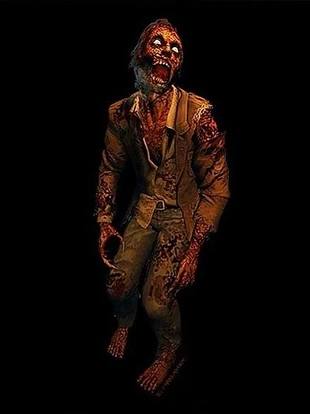
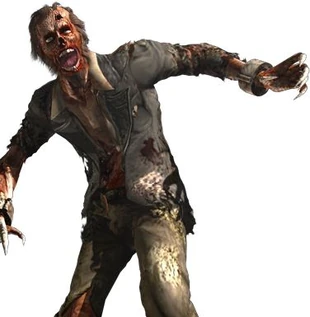
Crimson Head
Added in the 2002 remake is the "Crimson Head". One thing about the T-Virus zombies is that given enough of a spur (or plot convenience) they can cause their hosts to evolve a bit more. For the Epsilon Strain (which is featured in the original game), some zombies are able to develop additional mutations, theorized by the Umbrella staff to be a last-ditch effort of the virus to preserve its host. In Doylist terms, it's an excuse for the game designs to introduce 'elite' zombies with different appearances. The Crimson Head is honestly not that different, just with, well, red heads because their heart pumps blood really fast (which also gives a steam effect not unlike Attack on Titan giants), as well as growing giant ghoulish claws. One of them, Crimson Head Prototype 1, ends up as an extra mini-boss in the remake.
Not really a whole ton to say here, it's a cool variant, sure, but they're clearly not going anywhere near as overboard as the games from RE3 onwards would get. I do like it, though, they're clearly trying to fit Crimson Head here to the more grounded (sorry, relatively grounded) vibe of the first game. In the greater Resident Evil lore, the Crimson Head is sort of the 'middle ground' before a zombie mutates fully into a Licker.
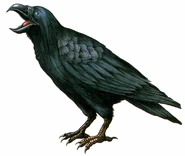
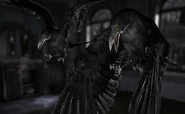
Crow
As you can see, a good chunk of Resident Evil's batch of enemies are zombie animals. Which... okay, sure, that makes sense; Umbrella's using these animals as test products, yeah? And hey, you get to fight dangerous, spooky animals, that's a video game standard. Crows are inherently spooky birds, and add a whole amount of atmosphere to the setting. Interestingly, the crows themselves don't display as much of a dramatic change like the Cerberus becoming half-zombies or the Web Spinner becoming hundreds of times larger, but they do become slightly larger and slightly more intelligent... in short, looking just like crows but unsettlingly creepier.
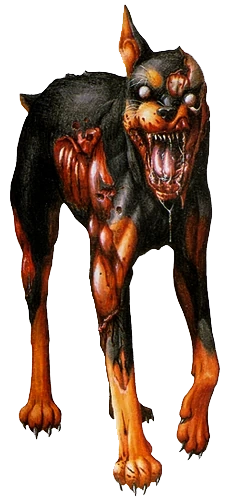
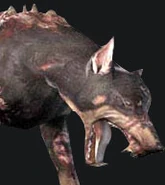
Cerberus
The Cerberus are zombie Doberman dogs! And I feel like the artwork best captures the wretched terror of zombie dog. I am a huge, huge dog person, but I would still admit that angry larger dogs just give this vibe of 'oh shit, don't fuck with this thing' aggressiveness. And the Cerberus, with its glazed-over white eyes, the exposed flesh at the side, and the half-rotten face? Yeah, a really effective deterrent for sure! Let me tell you, a half-rotted zombie dog is a thousand times more terrifying than just a regular skeleton dog. The Cerberus is very much iconic in the game for being the reason you're trapped in the mansion -- a massive pack of these Cerberus prowl the outside of the mansion and essentially locks you into the railway that the game designers want you to go... but then sometimes they'll fucking burst in and try and murder you anyway. The Cerberus are created from the Beta Strain of the T-Virus, which I think is meant to lean more towards being programmed hunter BOWs.
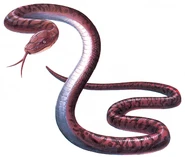
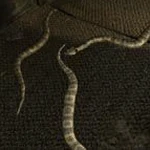
Adder
Far less iconic than the Cerberus or the Crows, the adders also don't show off too much of a visible change, other than an acknowledgement that they are a bit more venomous than normal variants fo their species. Not a whole ton to say here. They sure are snakes!
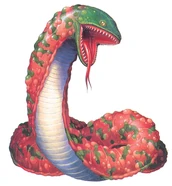
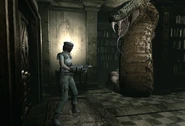
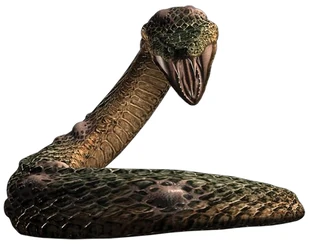
Yawn
Normally for these kind of games I save all the bosses for last, but we do have a bunch of bosses that are just bigger, scarier versions of regular enemies. And the big daddy snake? He's just called 'Yawn', because his mouth opens wide. The original artwork shows a much more weirder-looking snake with a skin that looks bizarrely like some sort of warty toad, terminating in a fangless mouth. The Yawn that you actually fight in both the original and remake is just a big-ass viper with fangs, and with noticeable mottled flesh in the 2002 model. Whereas the adders you meet just get infected by the T-virus by eating random small animals that carry the strain, Yawn was actually an Umbrella B.O.W., which explains why its mutation is so much more dangerous. The Yawn sort of stalks your characters and is fought a couple of times, and it's noted that it's developed amphibian-esque mutations that allow it to regenerate a bit faster... while, also, y'know, being big enough to gulp adult humans like rats. Actually low-key my favourite boss in the game because of how cool the visuals of it slithering through the mansion's corridors is.
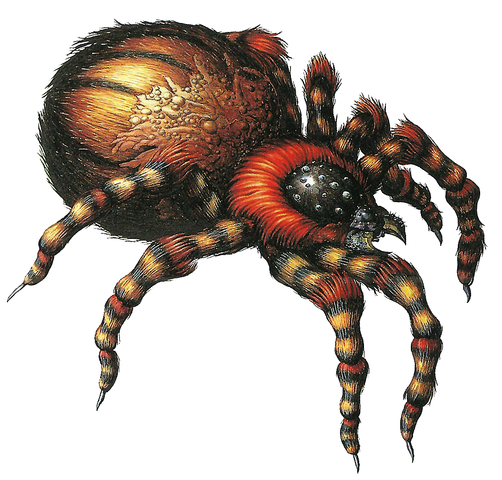
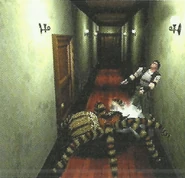
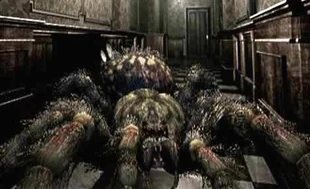
Web Spinner
Yeah you got to have giant spiders in a video game, and we've got giant zombie spiders. I'm not sure why, but I very rarely ever see zombies or the undead take the form of invertebrate creatures other than Resident Evil's franchise. It's interesting just how much the Web Spinner (whose name is a misnomer; they don't spin webs) has evolved between the two versions of Resident Evil 1. The original artwork shows a much more unconventional spider, with half of its abdomen covered with a rotten cancerous growth, it's got weird knobbly legs, it's got scary mouth-parts... but most striking is that its entire cephalo-thorax covered with little dots that are actually eyes, way more than a spider should have (and they have up to eight!)
In the actual games, the spider models in 1998's Resident Evil are just big spiders with more normal spider proportions, and they get replaced with extremely photorealistsic scary giant tarantulas in the 2002 remake.... although a closer look of their model does show them with a more monstrous, non-spidery mouth underneath those pedipalps. The Web Spinner is a result of the Alpha Strain of the T-Virus, which was noted to basically produce rampaging animals with little intelligence, unlike the more controllable (if still feral) Beta-strain Cerberus, and are noted by some in-game text to be basically a 'discontinued' model. Interestingly, the Web Spinners are still able to breed (because, well, the T-virus doesn't always kill its host entirely). While they are not exactly visible in the in-game models, when you kill a Web Spinner the 'babies' it carries on its back (like a wolf spider!) will be released to avenge mommy.
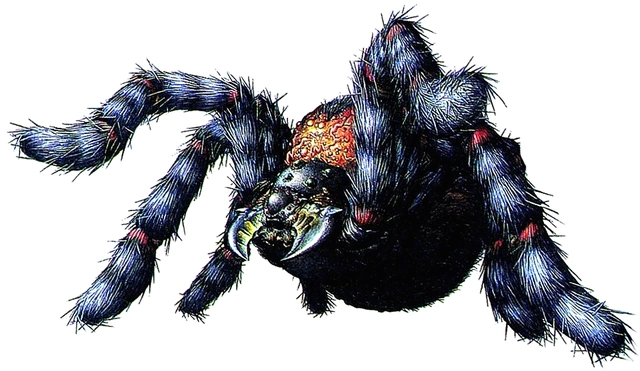
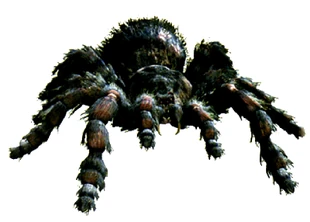
Black Tiger
The big mama of the Web Spinners is the Black Tiger, the 'queen' of the spiders in Spencer Mansion. Spiders aren't normally eusocial animals (tarantulas certainly aren't) but this isn't the first time that fantasy spiders have the same 'queen' layout as ants or bees. The Black Tiger is even bigger than a regular Web Spinner, and is an escaped B.O.W. that was single-handedly (eight-handedly?) responsible for the Web Spinners that are wandering around the mansion despite the B.O.W. type supposedly being discontinued. Unlike its offspring, the Black Tiger is actually able to spin webs. In the remakes, the Black Tiger is apparently modelled after the Australian Funnel-Web, which is one of the few actual species of spiders whose venom can be deadly to humans. Neat!
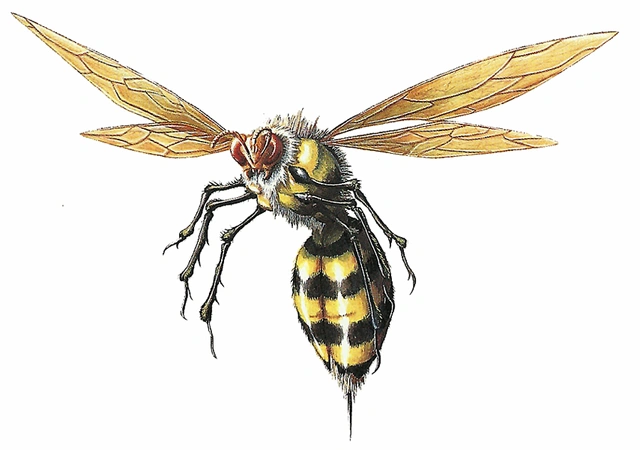
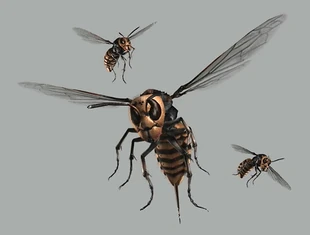
Wasp
Another invertebrate zombie, it's actually kind of interesting to see wasps be included alongside spiders, snakes, crows and dogs as 'spooky' animals in a zombie game. then again, looking at the 2002 model which is a dead ringer for the world's biggest jackass of an animal, the Asian Giant Hornet, makes sense. Wasps and hornets are extremely terrifying, and if you've never been stung by one, or be warned about the consequences of being stung by one, be thankful you live in a place where these little yellow-and-black motherfuckers don't live. The wasps don't grow as large as the Web Spinner, but they're still mutated enough by the T-Virus to be the approximate size of a crow. Nasty!
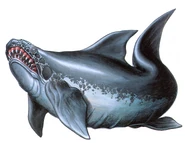

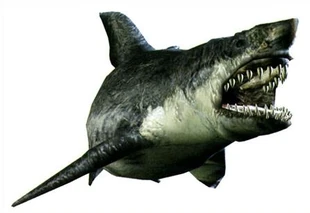
Neptune
ZOMBIE SHARK! Yeah, somehow, they managed to fit a pool large enough to keep a giant zombie shark in the Spencer Mansion. Those crazy, crazy Umbrella Corporation people! The original artwork for the Neptune features a much more mutated looking beast, with more flipper-like fins, a decidedly non-shark-like tail and a face that seems scrunched up and covered with a web-like layer. It sort of looks like one of those prehistoric carnivorous whales... but in-game, it's just a regular ol' zombie shark with a slightly mottled nose. It's noted that the Neptunes were Great White Sharks that were infected with the Alpha-Strain, which sure mutated them and made them more aggressive, but didn't cause as much of a chance as they hoped. Very neat that they included a shark of all things as a fun little boss fight.
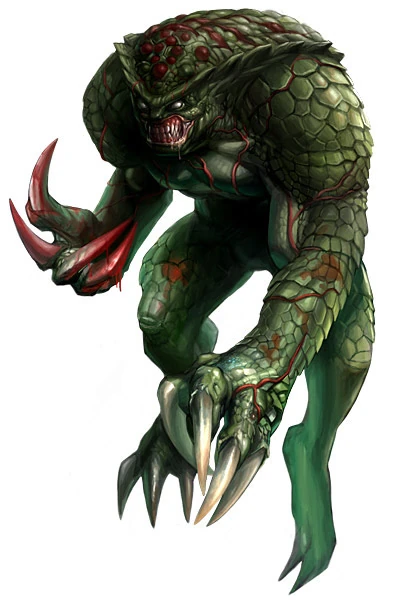
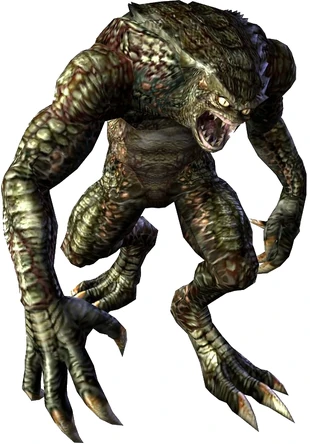
Hunter Alpha
You'll notice we covered a lot of things that are just zombie animals, and that's by design. I'm getting boring zombie humans and animals out of the way before we get into the actual bio-weapon zombie horrors that Umbrella is making. One of the more simpler ones is the Hunter Alpha (originally just 'Hunter', I believe), which is a humanoid lizard-person! I do like the large, taloned claws, the general mottled look and the fact that the face is so close to its wide torso. Normally with these lizard-people you tend to try and copy the facial structure of a lizard's head, which juts out of the body. Unlike all of the other weirdo animals and half-rotten zombies and dogs, the Hunter Alpha is actually a perfected bio-weapon, the end goal of Umbrella's experimentation with weird zombie-making viruses.
And I do like this design a bit. Very understated compared to other more iconic Resident Evil monsters like the Licker or the Tyrant, but I do really like how, despite looking monstrous, the Hunter Alpha does look like a completed creature. The game's lore notes that Hunter Alphas are created by injecting reptile DNA and the T-Virus into a human embryo, turning it into, well, a cunningly intelligent -- and more importantly, controllable -- minion for the Umbrella Corporation. After the creation, the successful Hunter Alpha was cloned and essentially trained to become weapons for the Umberlla Facility. They sort of act like mini-bosses, displaying what Umbrella's end-goal ultimately is. Creating these sort of mutated super-humans to be controlled and used in warfare to explicitly tear and rend humans apart. In-game, the Hunters actually show up halfway through your journey through the mansion and essentially replace the zombies, being far, far more deadly and agile than the shambling zombos.
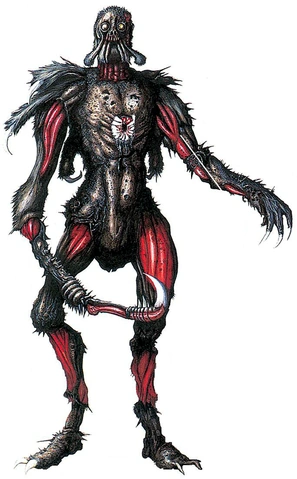
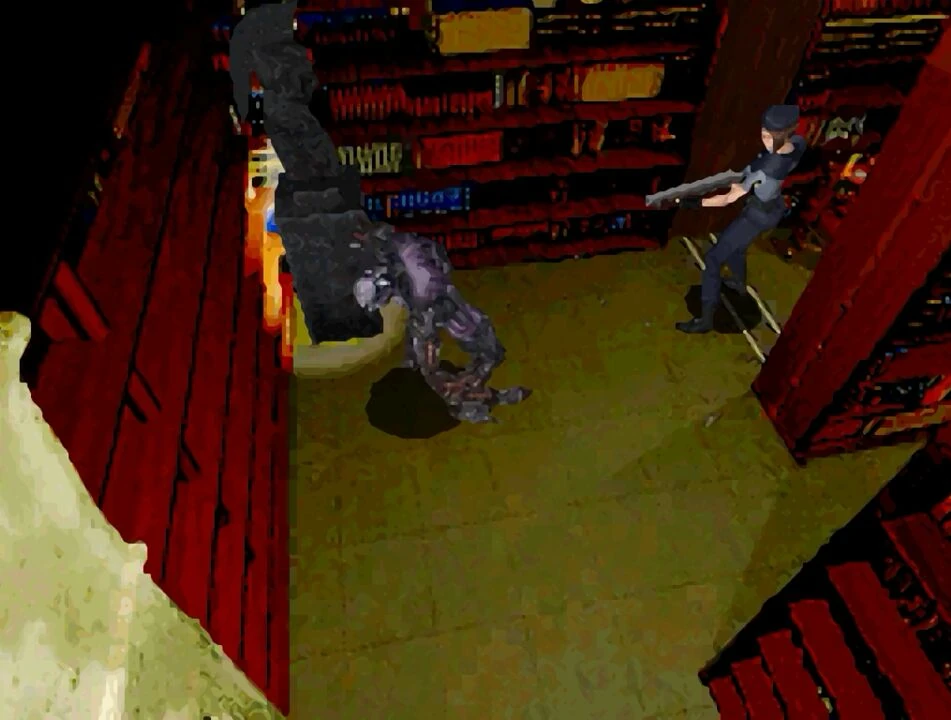
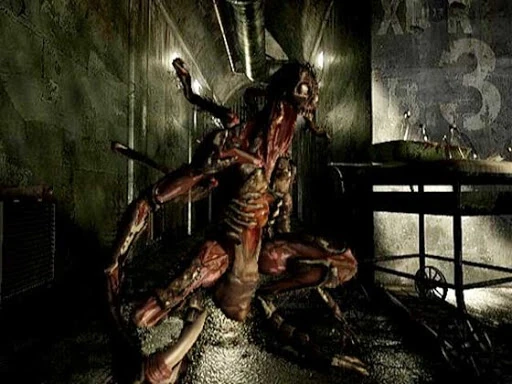
Chimera
Okay, this is a cool-looking one. The original 1998 model doesn't really make it clear what it's supposed to be, but the accompanying artwork and the faithful replication by the 2002 model does show us what this thing is... it's a bug-man! And I really do love just how wretched this creature looks. The 1998 artwork gives it a weird eye in the mouth, mismatched hands (one ending in a sickle and the other in spiky human fingers) and a weird spider-like face that just seems sad. The 2002 remake makes him more ghoulish and threatening, with extra bug legs, rib bones and bone spurs that jut out randomly (and he loses the chest-eyeball) and seems to always be in a squatting position.
The Chimera is a human/housefly hybrid, and it's noted to explicitly be a test run for the human-animal-virus hybrids that would be perfected with the Hunter Alpha. The Chimera is explicitly noted to be a failed product, and apparently the handful of Chimeras that our heroes meet are more or less like a 'bonus' enemy hiding in some parts of the underground Arklay Laboratory -- I think the remake makes it a bit more prominent? A pretty cool, wretched-looking creature that I feel is a very great contrast to the more complete feel of the Hunter or the Tyrant.
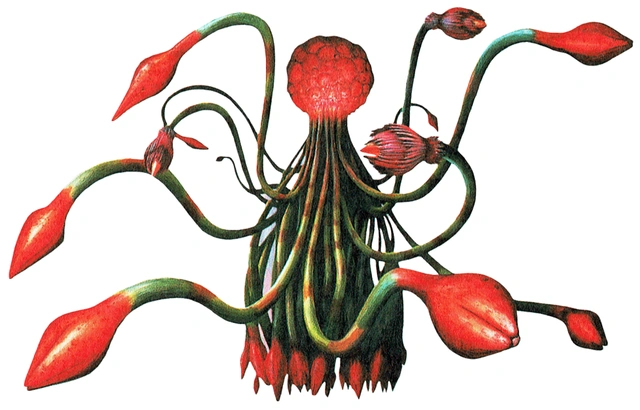
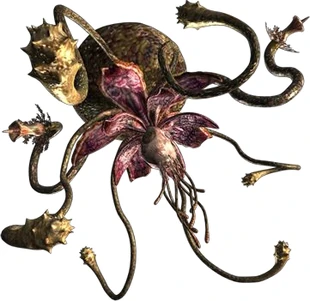
Plant 42
I like the very fun name that makes it clear that this is just the latest in a series of experiments. Most of Umbrella's creations were human or animal based hybrids, but apparently one of the scientists in Arklay Laboratory just got really curious and injected some random plant with the T-Virus. One of them, Plant 42, ends up mutating wildly and began to grow its roots and vines all throughout the the Spencer Mansion, and is also noted to be responsible for transferring the T-Virus into the wasp colony that fed on its sap. By the time of Resident Evil, our STARS people would discover that Plant 42 took over an entire dormitory building and is using its vines to capture and drain the blood of researchers. It's also gigantic, too, and you even meet some of its vines at some parts of the mansion before encountering the 'core' of the plant, suspended from the ceiling of a large room.
Plant 42 also is one of the creatures to receive a significant revision between the 1998 and 2002 games. Original Plant 42 was this odd jellyfish-like being whose central body is the orb-like head, and it's got a swarm of tentacle bulb-limbs that whips around and helps it manipulate things. The 2002 remake still has it be a giant plant-orb with a bunch of vines, but the vines are knobblier and it's got an extra central 'flower head' akin to something like an octopus. The central part of the flower has a little mass of smaller vine-tentacles. It's a giant sentient plant that's taken over and is beating people to death and draining their blood; a bit of a more standard 'plant monster' than the other plant monsters in the franchise, but I appreciate it all the same.
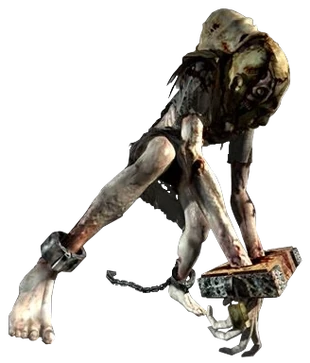
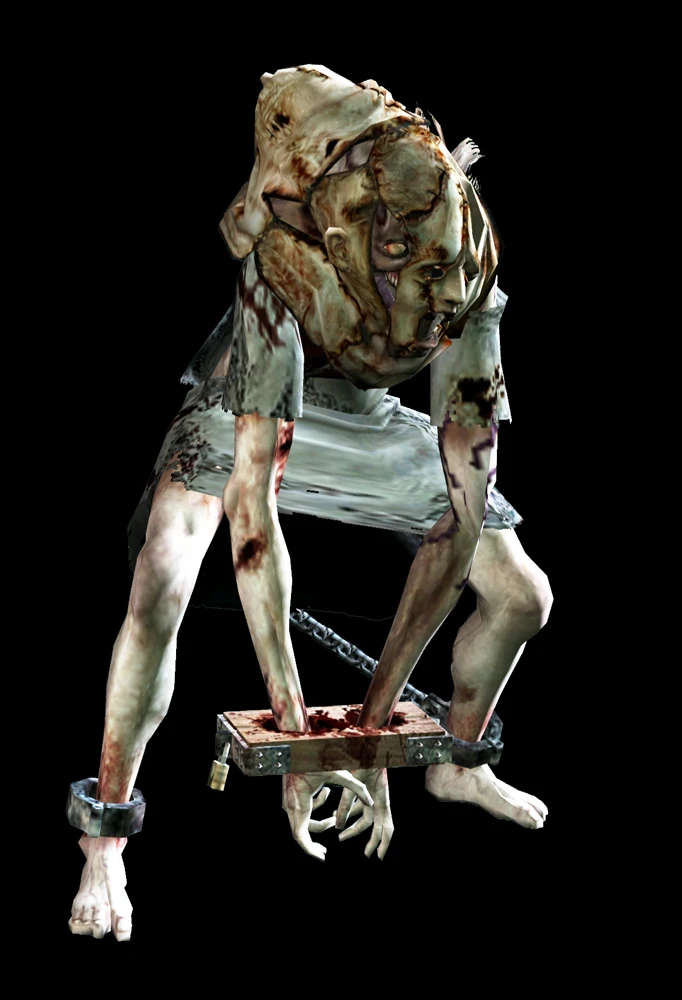
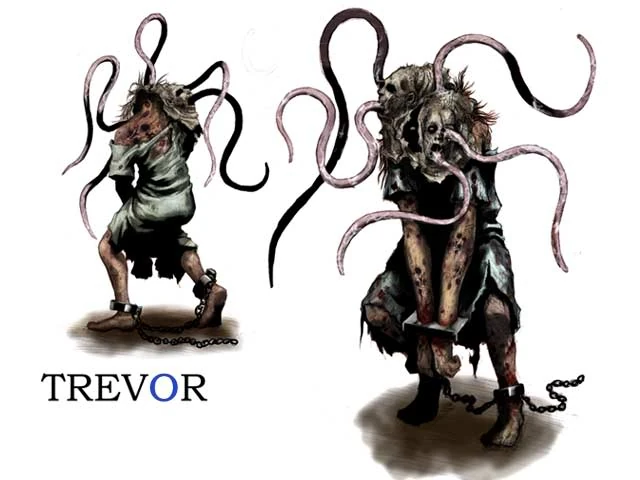
Lisa Trevor
This boss is created and is an additional part of the game in the 2002 remaster, and while I'm no expert on the storyline (remember, I've not really played through the game personally) from what I can glean via a watch of a playthrough of the remaster and the synopses, Lisa Trevor does really add a whole lot into the original Resident Evil story. Sure, the original RE does have a lot of fun tension, horror, and the buildup of the terrible bioweapon-producing evil science that Umbrella Corporation is making. But one thing that the original Resident Evil is missing is to show the victims -- more than just random investigative cops that get killed by plant and dog zombies, that is.
So in comes Lisa Trevor. Without spoiling too much about what the character is (and it's going to take a long while if I give a synopsis about every single 'character' boss, which will be the norm from RE2 onwards) Lisa Trevor was the daughter of the Spencer Mansion's original architect, who found himself betrayed and murdered by Umbrella Corporation after he designed the house of traps and secret corridors. Lisa and her mother were captured and used as guinea pigs for some thirty years... and ended up surviving all of these experiments, with multiple strains of the T-Virus, what would becmoe the G-Virus, as well as the NE-Alpha Parasite (those two are the main baddie pathogens in RE2 and RE3 respectively, in a nice bit of chronological foreshadowing and tie-in) into her body, and this cocktail of parasites and virus instead cancelled each other out and fused with her DNA, creating a completely indestructible creature that can only be mercy-killed by tricking her into jumping after her mother's coffin into a crevice.
In a pretty sad, sympathetic turn (and your characters discover this as they gather fragments of Lisa's madness-induced diary ramblings as well as research notes), poor Lisa's mind has regressed into thinking that she's still the same, cute little girl before she got turned into a bioweapon, and still looks for her mommy and daddy.... even though, as you can see in that picture, she's skinned the faces of the two fake Umbrella Corporation agents that masqueraded as her parents, stitching them as some sort of a hideous flesh-mask because she's 'holding on' to their faces until mommy and daddy come home. Pretty sad, and I do like how the design really does give her a threatening look (especially when the combat tentacles come out) while also keeping her pretty sympathetic with those shackled arms and tattered hospital gown. An awesomely executed tragic monster with a very sad backstory.
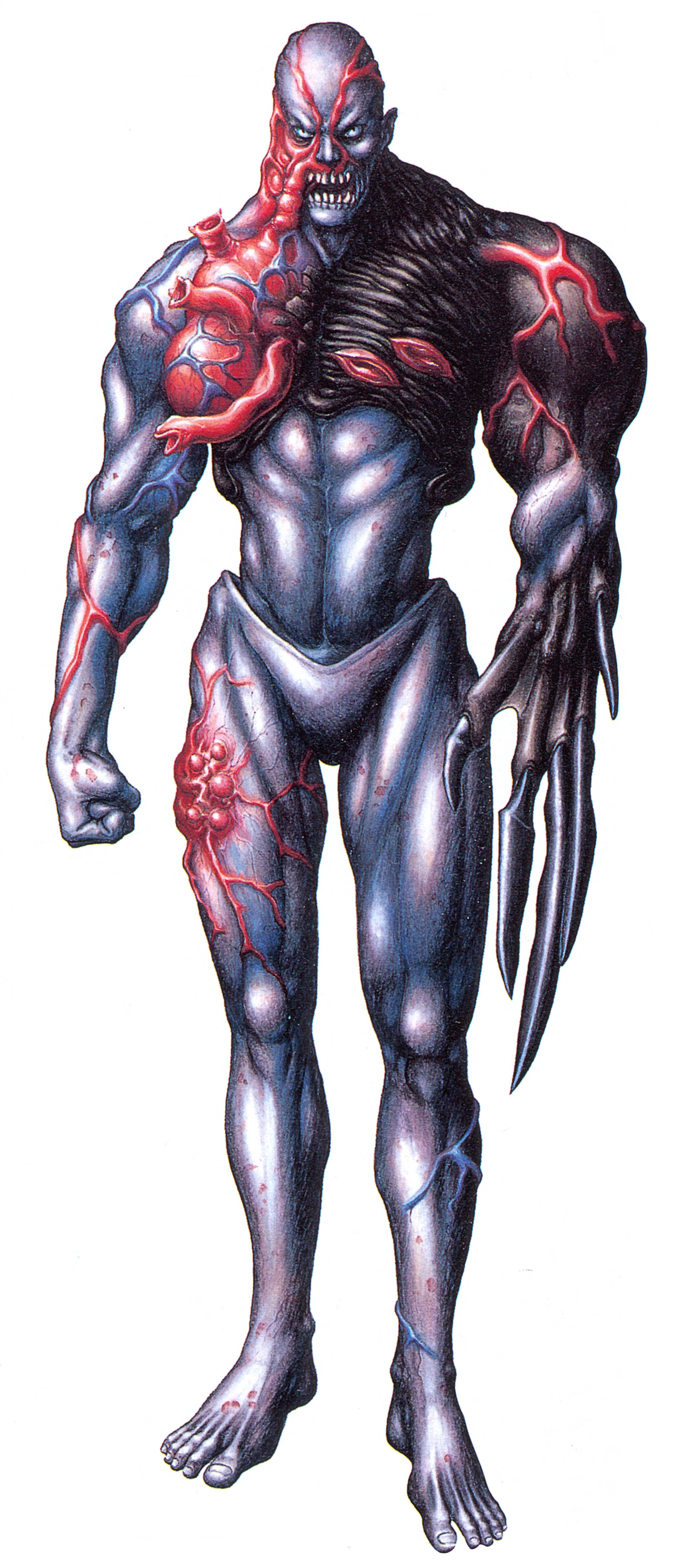
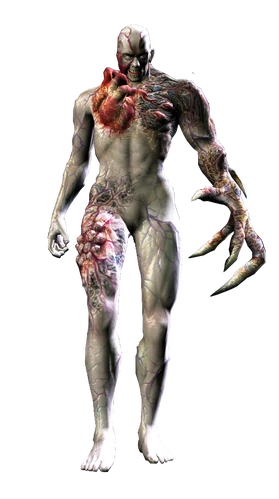
T-002: Tyrant
And here's the final boss for the original Resident Evil, the end-result of all of this human experimentation and the most powerful B.O.W. in the Spencer Mansion facility. The Tyrant might look quaint compared to the far more extravagant bosses in subsequent games, but he does set the sage of a giant, implacable man with mutations that make him harder to kill. And he's one of the handful of Resident Evil bosses to not have multiple phases of mutation. It's kind of underwhelming knowing the scope of how Resident Evil's monsters would go, but it's still a pretty cool zombie giant-man! Whether it be the original conceptual artwork or the two models in the games, all of the details of the Tyrant is still the same, with patches of blood and veins running around his body, and his left hand mutated into a massive, gnarly bone-claw. The concept art's bizarre, almost webbed fingers is far cooler, but I also still like the just ghoulishly long fingers of the models. More interestingly, in addition to all the veins that run around the Tyrant's body, we've got a second beating heart outside of the Tyrant's body! Oh, neat, a convenient Legend of Zelda style weak point, right? Wrong! That second heart is there for a reason, there as a secondary blood pump that only helps the Tyrant during growth, and is a sneaky little subversion to more genre-savvy gamers that would immediately assume that it's a silly design flaw.
More interestingly, the Tyrant is also completely sentient, retaining the same amount of intelligence that it had as a human before the conversion. It's not created as a bio-engineered embryo like the Hunter or the Chimera, nor is the Tyrant's mind shattered by insanity like Lisa Trevor. The downside is that not all humans can become a Tyrant, and only a specific gene strain allows humans to survive the Tyrant creation process. Also, the Tyrant that the characters fought in Resident Evil is noted to be the bare basics of what a Tyrant should be, with the virus outbreak happening before more bio-engineering grafting was able to be completed. The Tyrant is a great set-piece and a pretty cool final boss. And as much as I do like the weirder creatures like the Chimera, Plant 42 and the Hunter a lot better; and RE3 would make the 'badass muscular humanoid super-soldier' as a far cooler design. But it is certainly appropriate for the final boss in a game about surviving from bio-engineered zombies to be, well, a super zombie.
__________________________
And, of course ultimately all the bad guys died when Spencer Mansion was blown up... but that's hardly the end of Umbrella Corporation, or, thanks to cloning, generic engineering and superhuman-ability viruses, the end of the legacy of our villains like Albert Wesker (who isn't an enemy and we won't cover until if/when we reach a game when he's an actual boss) or the T-002. Still, that's a bit of a fun ride through the first Resident Evil game, a fun and honestly great spooky world of genetic engineering, bio-weaponry and viruses.
No comments:
Post a Comment